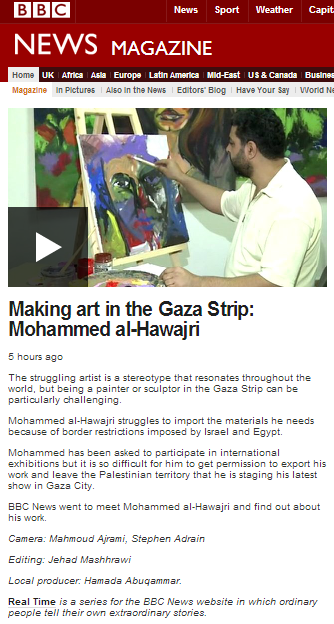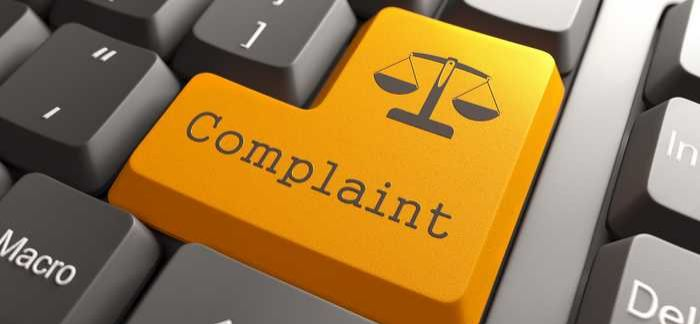On April 4th a video report titled “Making art in the Gaza Strip: Mohammed al-Hawajri” appeared in the BBC News website’s ‘magazine’ section, on its main home page and on its Middle East page. The report was also apparently shown on the BBC World News programme GMT.
The synopsis to the video report as it appears on the website reads:
“The struggling artist is a stereotype that resonates throughout the world, but being a painter or sculptor in the Gaza Strip can be particularly challenging.
Mohammed al-Hawajri struggles to import the materials he needs because of border restrictions imposed by Israel and Egypt.
Mohammed has been asked to participate in international exhibitions but it is so difficult for him to get permission to export his work and leave the Palestinian territory that he is staging his latest show in Gaza City.
BBC News went to meet Mohammed al-Hawajri and find out about his work.” [emphasis added]
The voice over to the report is narrated by Hawajri himself. [emphasis added]
“I am very interested in modern art. These are pictures that I paint of my children. We are not sure about our future here but I have use a lot of colour to show that we have hope.
My name is Mohammed al Hawajri. I am Palestinian artist from the Gaza Strip. My work is very affected by the situation here. Because of the siege in Gaza artists cannot get materials that we need. So, sometimes I make a sculpture from animals’ bones. I have done some paintings with the spices. You can smell it. This one uses curry and cumin. This is another part of my idea that you should use different senses.
This is my new project. It is an installation work. We are filming about the siege in Gaza. It is a critical of the situation but in a humorous way. It’s called ‘the red carpet’. People who support us in Gaza cannot reach us in normal ways. So the only way to enter is from the sea. I am rolling out a red carpet to welcome them and show respect.
Like everyone in Gaza I find it very difficult to get permission to leave. We can only get out through Egypt or Israel. Some galleries in Europe have shown my art work and I get many invitations to travel. My new exhibition is being shown here in Gaza City.”
No context is provided in this report with regard to why a partial blockade on the Gaza Strip exists. The words ‘Hamas’, ‘terrorism’ and ‘missile attacks on Israeli civilians’ of course have no place in this piece of filmed propaganda. Neither are viewers made aware of the fact that restrictions on the import of materials to the Gaza Strip are confined solely to dual-use goods which can be used for the purpose of terrorism.
As the lively flow of Western politicians, activists and journalists to the Gaza Strip indicates, Hawajri’s claim that “the only way to enter is from the sea” is patently inaccurate. No explanation is offered as to why the Gaza Strip does not have a functioning airport and no mention is made of the fact that thousands of people exit the Gaza Strip via the Erez crossing alone every month or that there are no restrictions on exports from the territory.
And what of Hawajri himself? Well, according to his self-composed Twitter profile he has visited Jordan, Italy, France, Switzerland and Egypt. According to his profile on the website of the Al-Ma’mal Foundation for Contemporary Art, Hawajri visited Jerusalem, Alexandria in Egypt and Pescara in Italy in 2008 alone. An interview Hawajri gave to Ramallah Online in 2010 states:
“Although Mohammed has been fortunate to be granted permission to travel, owing to his higher status, it saddens him that so many of his peers are refused. “It is the most difficult thing. The denial of participation and transfer of their art, and also depriving them of the exchange of experience with artists of the world.” […]
Al-Hawajri enjoys spending time abroad, but cannot stay away for long. “I like the freedoms in the West, but my thoughts and my art come from the crowded streets and markets of Gaza. Life is not natural, but my future is here”. “
According to his profile on the website of the artists collective to which he belongs, he was already working with animal bones in the year 1997 and with spices in 2002 – years before the Gaza Strip was declared a hostile entity in September 2007 and the partial blockade put in place due to the surge of terrorist activity after the violent Hamas coup. The choice of those media is therefore clearly not connected to any shortages of materials as the BBC’s report suggests.
Hawajri’s work is – according to his own description – political. Seven years after Israel’s withdrawal from the Gaza Strip he described one of his exhibitions in the following terms:
“In my latest project entitled Guernica-Gaza, I express the reality of the world and of the Palestinians, the life under Israeli occupation, racial segregation, violence, destruction, murder and assassination. [..]
I have chosen this title because of the similarities between the war in Gaza in 2008/2009 and the German aggression against Spain in 1937, during which the village of Guernica was destroyed.”
In this report the BBC News Gaza office has clearly self-conscripted to the promotion of a similar context-free cocktail of propaganda, art and politics which obviously flouts BBC editorial guidelines on accuracy and impartiality.





